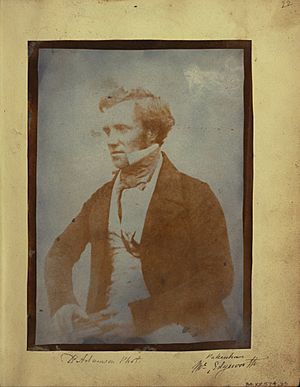Michael Pakenham Edgeworth facts for kids
Quick facts for kids
Michael Pakenham Edgeworth
|
|
|---|---|

Edgeworth c. 1843–1845
|
|
| Born | 24 May 1812 County Longford, Ireland
|
| Died | 30 July 1881 (aged 69) Eigg Island, Scottish Inner Hebrides, Scotland
|
| Citizenship | Irish |
| Alma mater | University of Edinburgh |
| Partner(s) | Christina (née Macpherson) |
| Scientific career | |
| Fields | botany |
| Author abbrev. (botany) | Edgew. |
Michael Pakenham Edgeworth (born May 24, 1812 – died July 30, 1881) was an Irish botanist. He was an expert in seed plants and ferns. Michael spent most of his life working in India. He was also one of the first people to use photography in his scientific work.
Contents
Early Life and Family
Michael Pakenham Edgeworth was born in Edgeworthstown, County Longford, Ireland. This was on May 24, 1812. He was one of twenty-four children born to his father, Richard Lovell Edgeworth. Michael's mother, Frances Beaufort, was his father's fourth wife.
His older half-sister, Maria Edgeworth, became a famous writer. Michael married Christina Macpherson in 1842. They had two daughters, Harriet and Christina. Sadly, their second daughter, Christina, died when she was a baby.
Education and Early Career
Michael went to Charterhouse School in England starting in September 1823. Later, he studied languages and botany at the University of Edinburgh in Scotland from 1827.
In 1829, he joined the East India College, Haileybury. This led to him working for the East India Company in 1831. The East India Company was a powerful British trading company that also governed parts of India.
Travels and Discoveries
Even though Michael owned land in Ireland, he joined the Bengal Civil Service. This meant he worked for the British government in India. He held different government jobs in places like Ambala, Muzaffarnagar, and Saharanpur.
Michael was very curious and loved to travel. He explored many parts of northern India. During his travels, he collected many plants and wrote detailed notes about them. He was also interested in Indian languages, culture, and old historical sites.
He kept in touch with scientific groups back home. In 1842, he became a member of the Linnean Society of London. On a trip back to India in 1846, he stopped in Aden. There, he collected 40 plant samples. Eleven of these were new species that no one had ever described before! He wrote about them in a science journal.
Michael even met famous scientists like Charles Darwin. Darwin mentioned a conversation he had with Edgeworth and other biologists at a meeting in 1861. This was soon after Darwin's book On the Origin of Species came out.
Photography Pioneer
Michael Edgeworth was also a pioneer in using photography for botany. From 1839, he experimented with early photographic methods. He made daguerreotypes and photogenic drawings of plants. Some of these early photos still exist today.
Later Life and Death
Michael retired in 1859 and moved back to London. He died suddenly on July 30, 1881, on the island of Eigg in Scotland.
Published Works
Michael Edgeworth wrote thirteen papers on botany, climate, and his travels. Some of his important botanical works include:
- Descriptions of Some Unpublished Species of Plants from North-Western India (1851)
- Catalogue of Plants found in the Banda district, 1847–49 (1852)
- Pollen (1877)
He also kept detailed diaries from 1828 to 1867. These were later put together into a huge 8,000-page book. It was called India in the Age of Empire - The Journals of Michael Pakenham Edgeworth (1812–1881). His journals tell us a lot about how the British Empire grew in India.
Plants Named After Him
Many plants were named in honor of Michael Pakenham Edgeworth. The plant group Edgeworthia was named after him and his half-sister, Maria Edgeworth. Other plants named after him include Primula edgeworthii, Rhododendron edgeworthii, Impatiens edgeworthii, and Platanthera edgeworthii.

